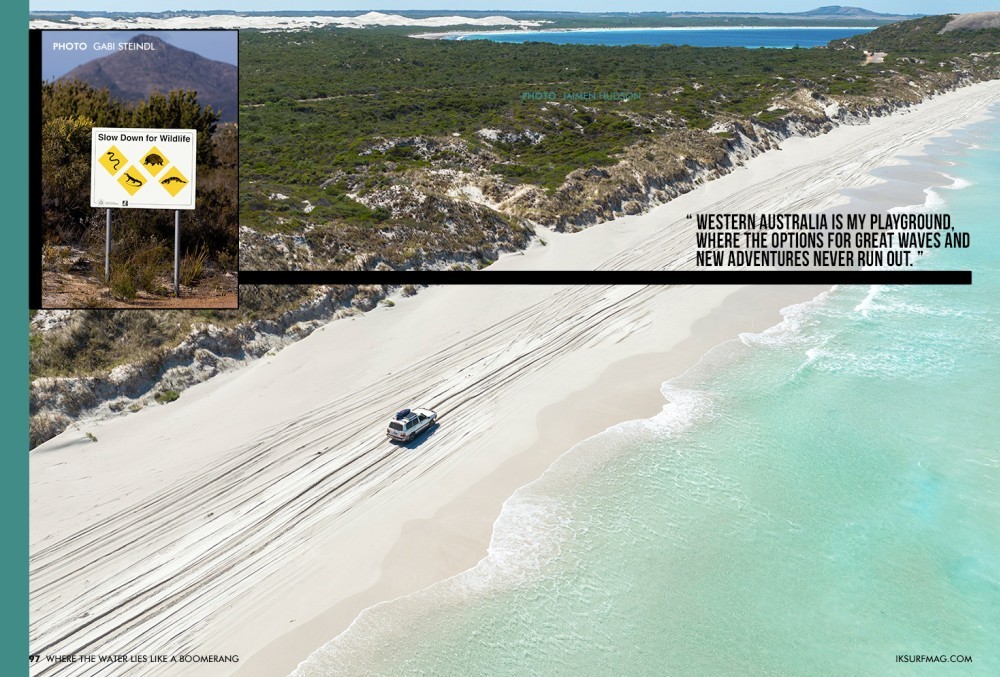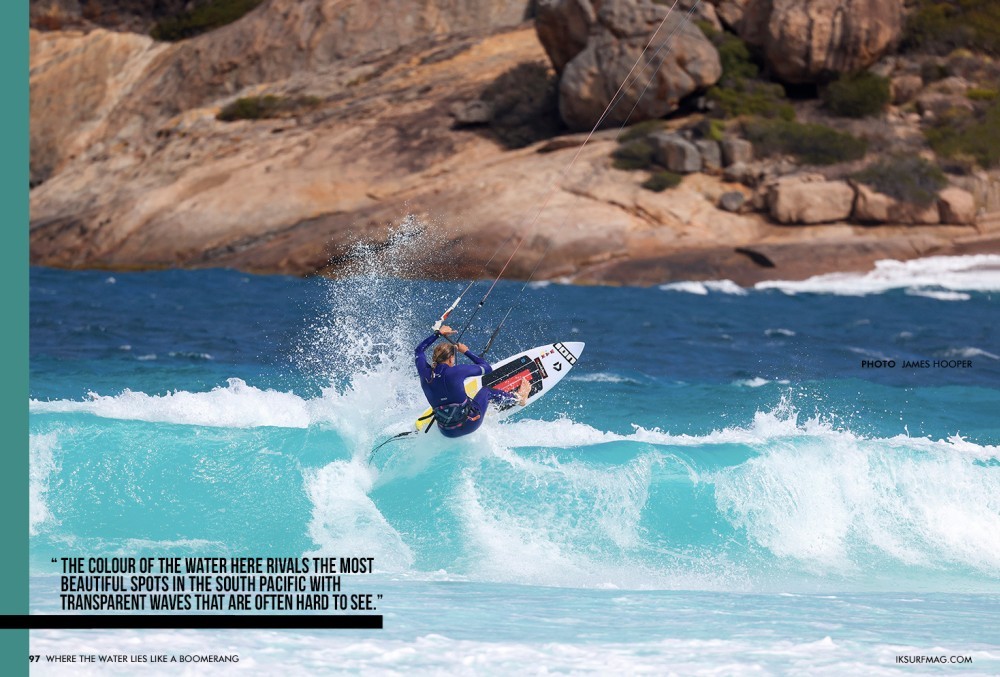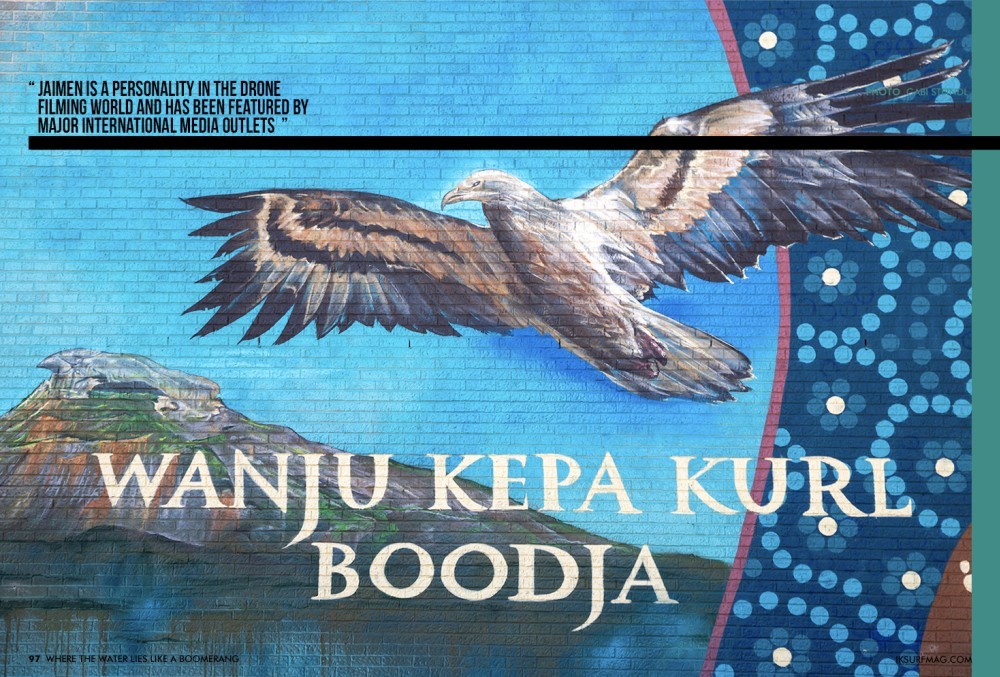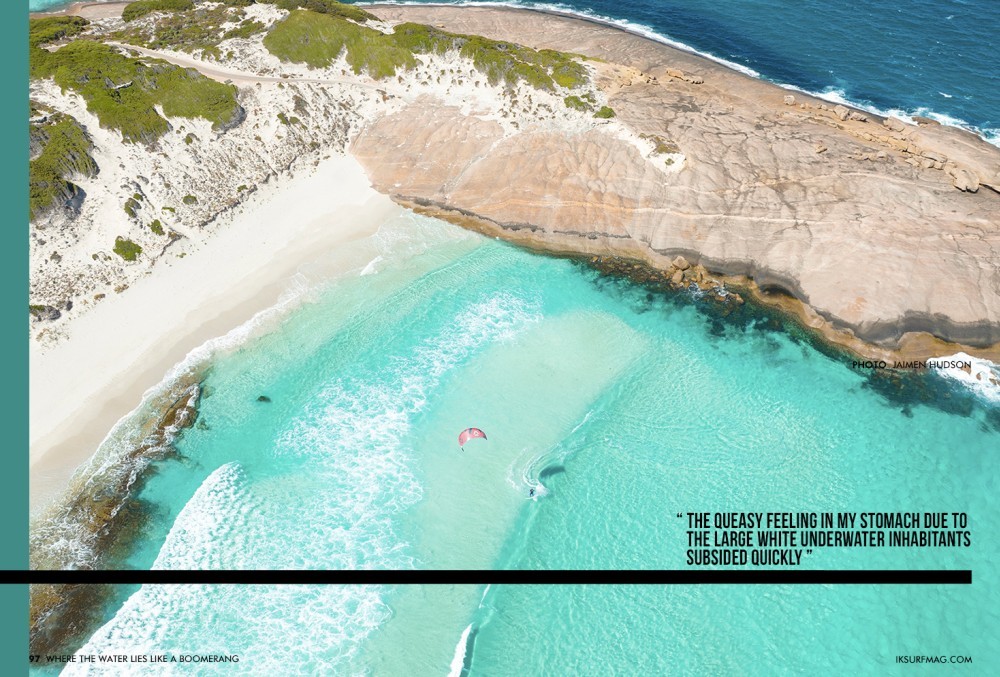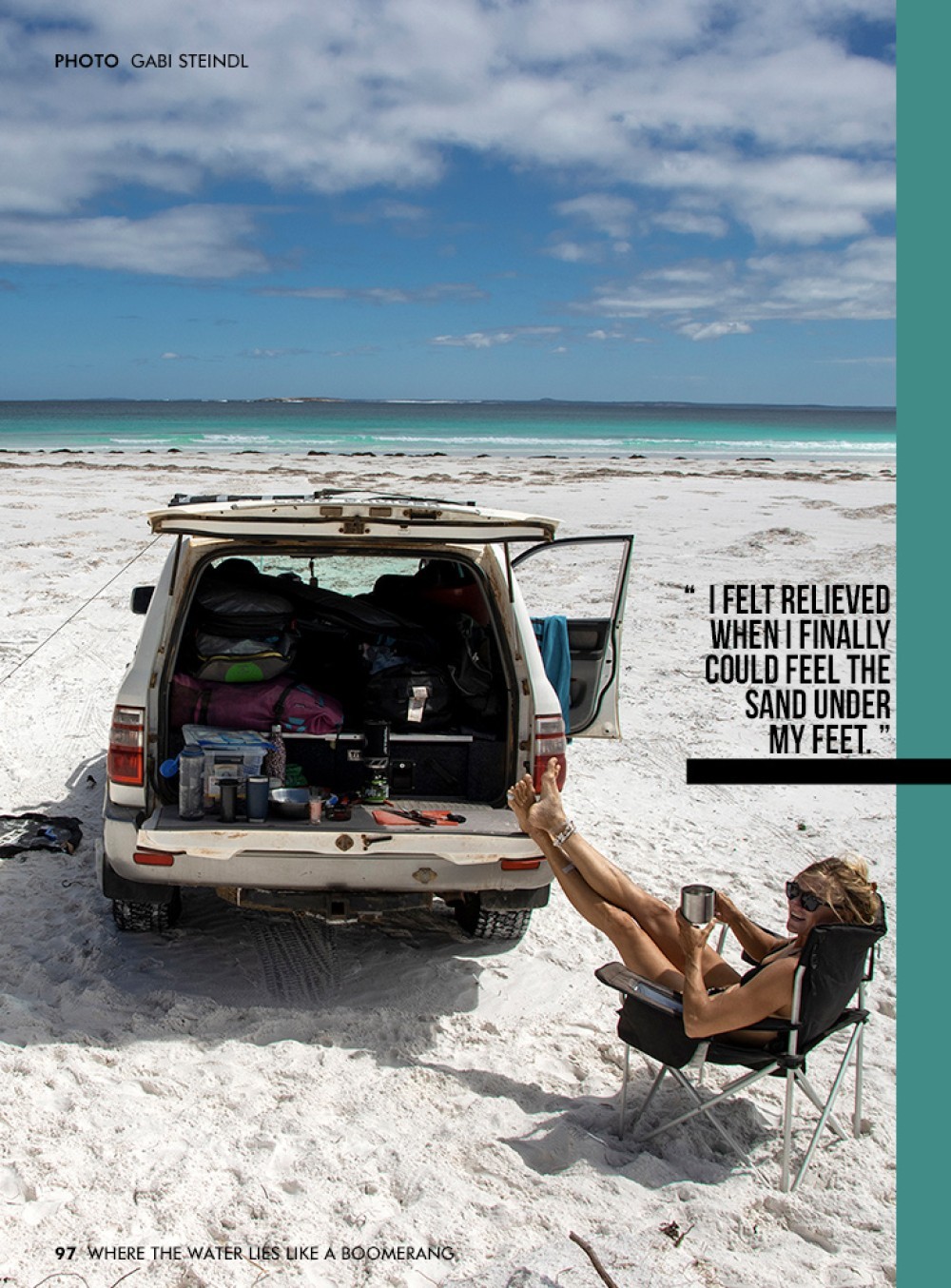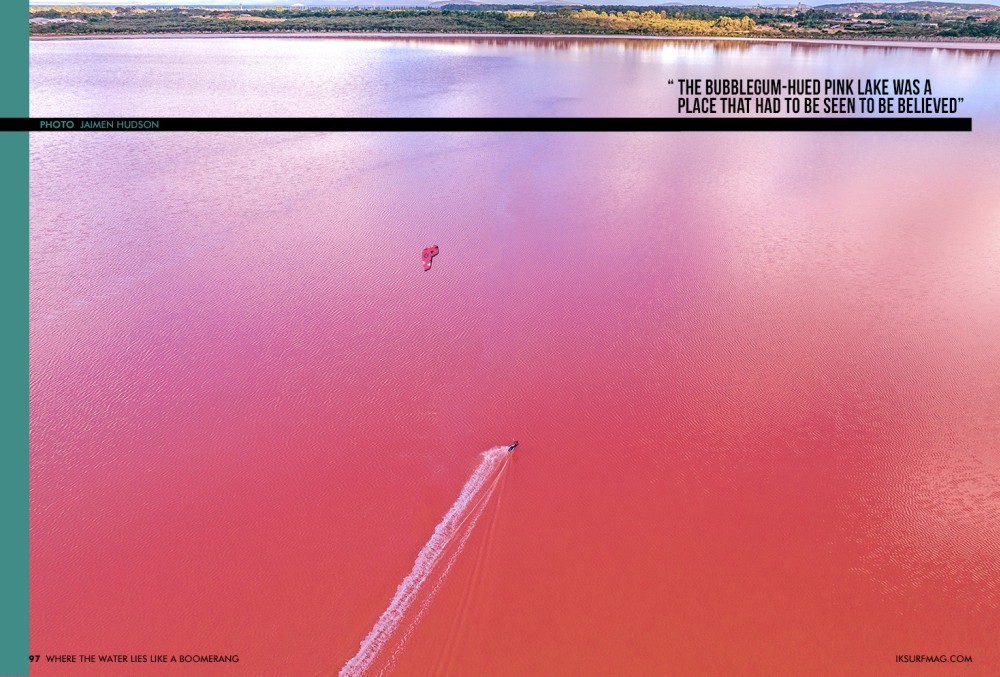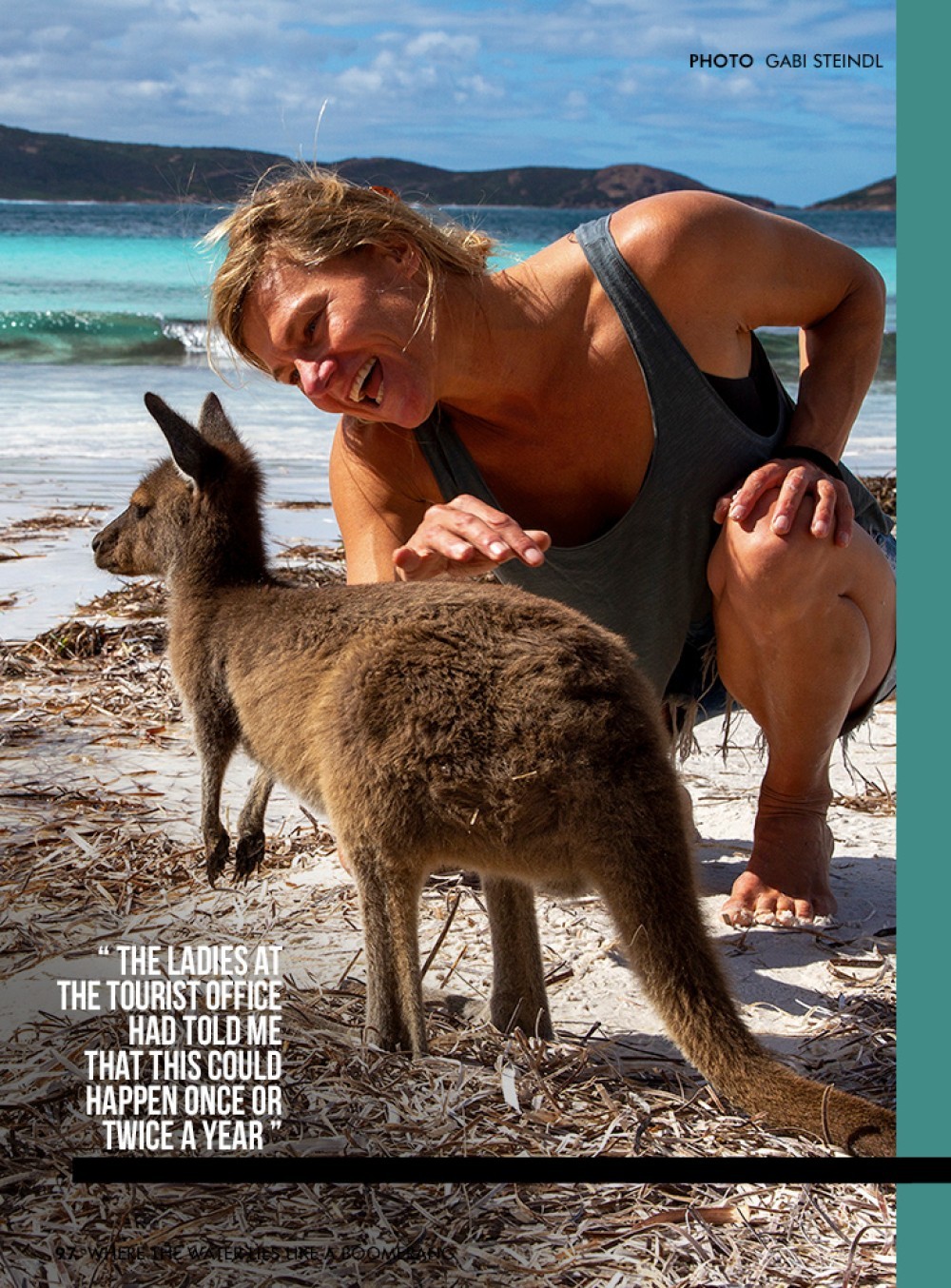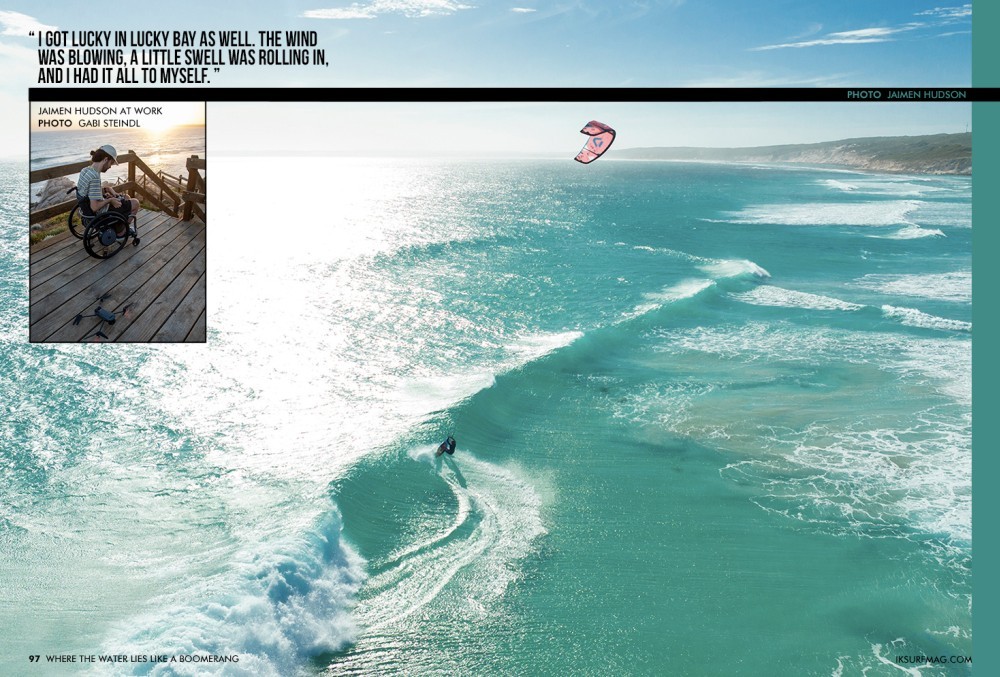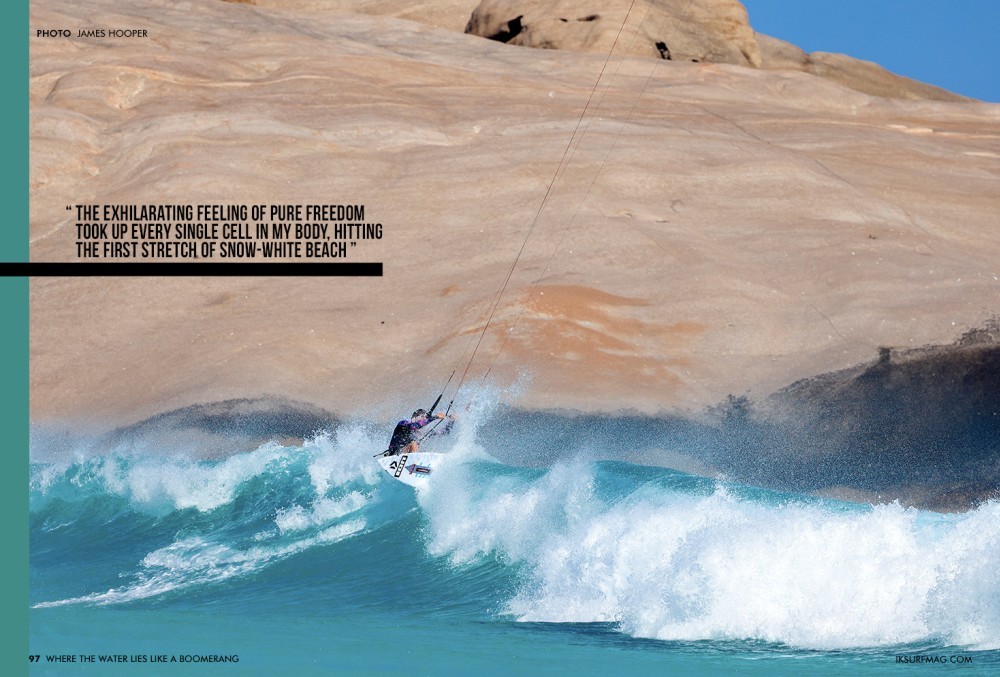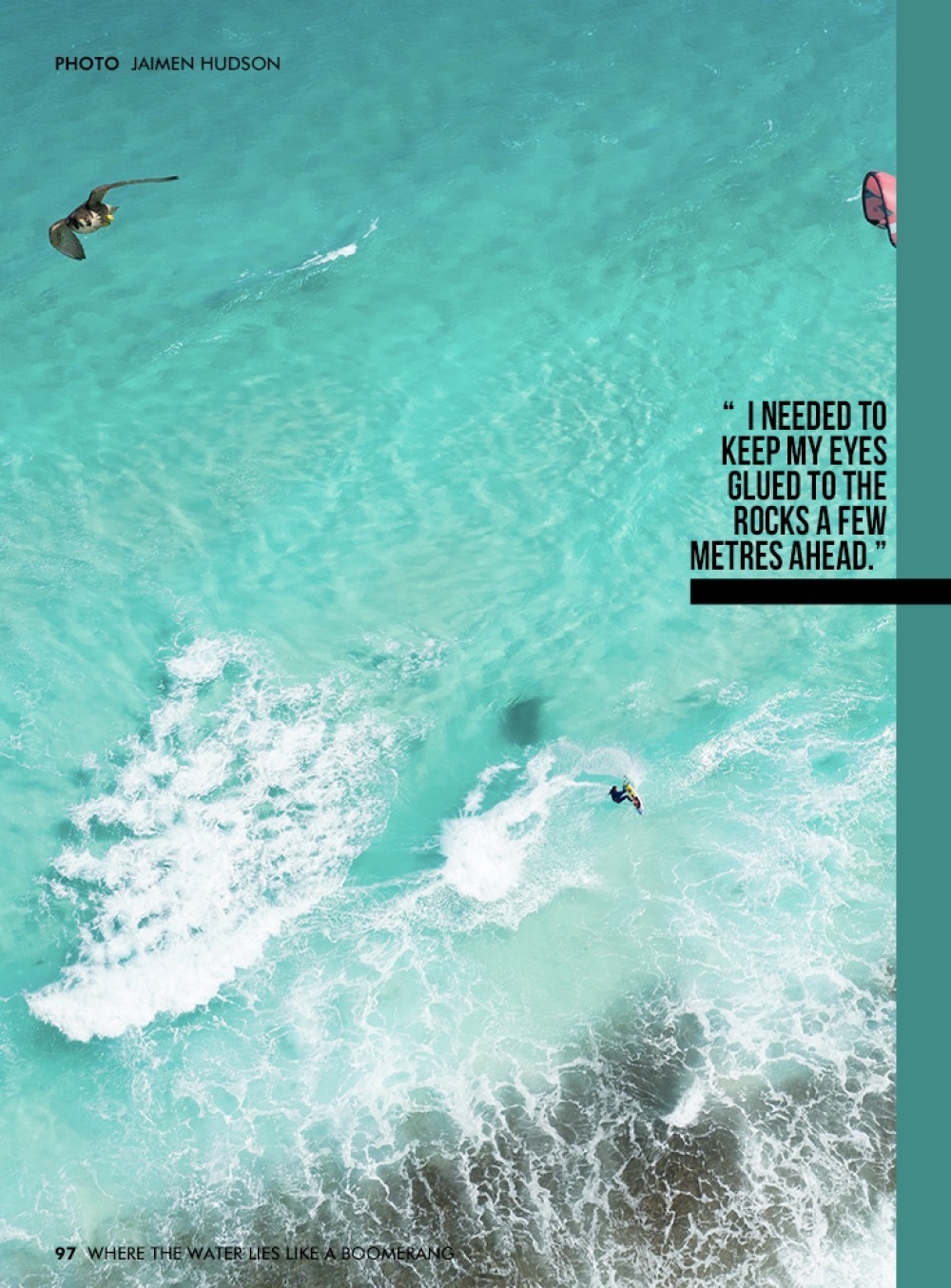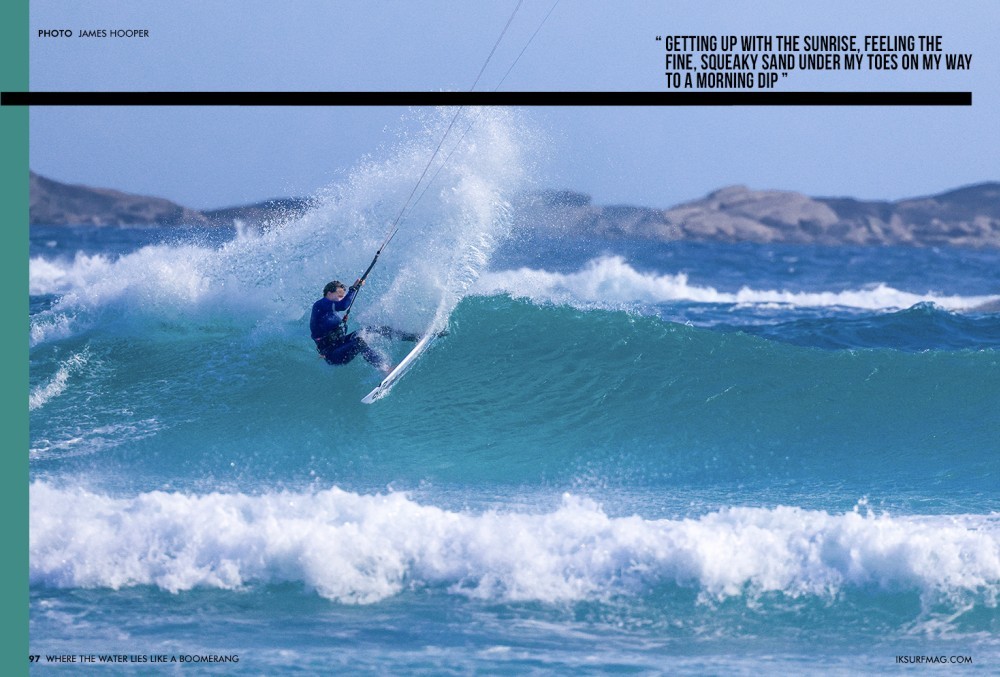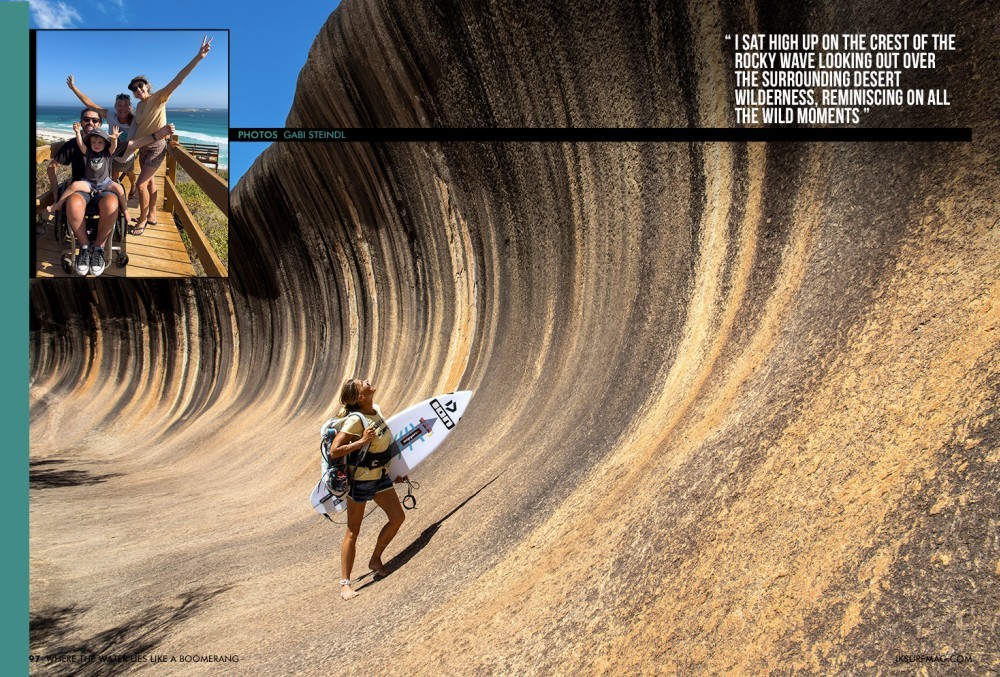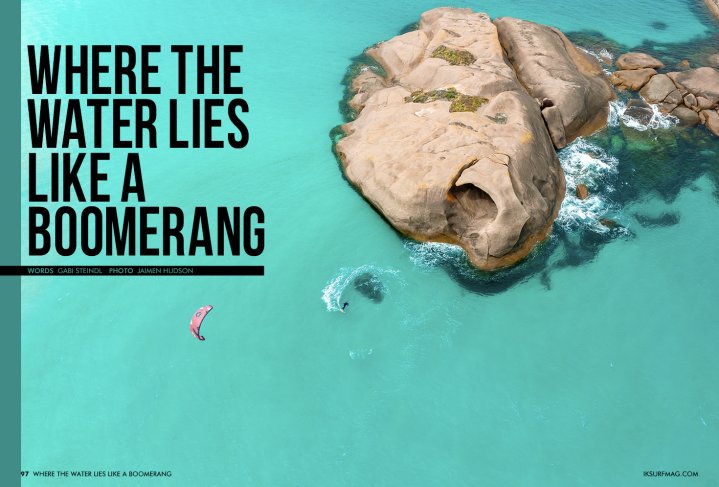
Where the Water Lies Like a Boomerang
Issue 97 / Fri 10th Feb, 2023
With a massive area of 2.6 million km2 and some of Australia's most iconic landscapes, Western Australia is the home of the iconic road trip. Follow Gabi Steindl as she explores its scenic and rugged beauty, epic surf spots and one of the most pristine (and sharky!) coastlines in the world!
"Are you travelling all alone?" The ranger looked at me, puzzled. "Yep," I replied with a big smile. His eyes inspected my Landcruiser. "You're carrying off-road recovery equipment, yeah?" "Ehm, nope," I played it cool, but his questions made me a little nervous. "And you're planning on sleeping alone on the beach?" "That was the plan." "Countless cars have already fallen victim to the beaches here. The sand is really soft in places and very, very deep. Hopefully, you've got an air compressor and know a thing or two about tire pressure?" "Absolutely." Whether he believed me or not will remain unknown. "Well then, good luck!" "Thanks, mate."
I first came to Western Australia in 2007 to shoot a kiteboarding road trip story with a New Zealand photographer and fell head over heels in love with the Margaret River region of the South West. I am now a permanent resident and have been married to an Australian big wave windsurfer for 12 years. Margaret River is my home, and Western Australia is my playground, where the options for great waves and new adventures never run out.
On this trip, I wanted to explore some more remote stretches of the south coast of WA. With my jam-packed Toyota Landcruiser — loaded with two wave kiteboards, a surfboard, a foil board, six kites, several bars, harnesses, wetsuits, my swag (one of the greatest inventions known to mankind!), an Engel car fridge, gas cooker, camping chair, camera gear, and the most important kitchen utensils — I kissed my husband goodbye and hit the road.
The first obstacle I had to tackle was crossing the Thomas River. My heart fully started pounding when the river water sloshed over the bonnet of my Landcruiser. On the other side, I stopped the engine, took a deep breath and let the tires down to 15 psi. The real adventure was about to begin!
The Esperance area, about 800 km from Margaret River, is an isolated paradise on the coast of the Southern Ocean and is famous for its breathtaking beauty. The Wudjari People of the Noongar cultural group (also Nyungar, the Indigenous Australians of South West Australia) are the true locals and the traditional owners of this region. Their name for Esperance is Kepa (Water) Kurl (Boomerang), meaning 'where the water lies like a boomerang'. Fundamental to Noongar and Wudjari identity and culture is a strong connection to the land with a deep sense of responsibility to both manage and nurture their "country" (Boodja or Boodjar) and everything connected to it.
The region around the small town of Esperance, with only 12,000 inhabitants, officially has two of Australia's whitest sand beaches, so fine the sand squeaks underfoot. The colour of the water here rivals the most beautiful spots in the South Pacific with transparent waves that are often hard to see. Unfortunately, Esperance is also known for giant white sharks, and in the last three years alone, there have been three fatal shark attacks and a number of near-misses. Five days before I arrived, an 18-year-old girl was attacked and miraculously survived despite severe wounds.
I was excited to finally meet Jaimen Hudson, who grew up here. As a well-known aerial photographer and drone pilot, I had been in contact with him for quite some time about various photoshoots I had planned in the area. From the very first phone call, I felt a special connection with Jaimen.
Jaimen is 31 years old and has been a quadriplegic since he was 17 when he was involved in a serious motorbike accident in the sand dunes just out of town. Before the accident, surfing, skateboarding, and scuba diving ruled Jaimen's life. His earliest childhood memories are of the days on the water with his mother and father, who ran a scuba diving school and boating business. About eight years ago, Jaimen became interested in drone photography and videography, but due to his limited hand function, he feared that he would never be able to operate a drone himself until he bought one in 2015. Now, Jaimen is a personality in the drone filming world and has been featured by major international media outlets such as The Huffington Post, BBC, The Sunday Times, BBC Earth and many more. Besides his filming and photography business, Jaimen bought and now runs his parents' family boating business with his wife Jess, a Canadian from Vancouver Island. Their three-year-old son, "Captain," is a real trooper, and a second child is on the way.
In an extremely stylish, black VW Multivan modified for Jaimen to drive himself, he dashes along the coast every day before sunrise in search of wildlife. Dolphins and whales are usually the main subjects of his phenomenal footage. Until then, he had never shot kitesurfing and was just as excited as I was. "The wind forecast looks good for the afternoon," I said, "let's meet at West Beach around noon." "Perfect!" Meeting him in person and finally experiencing his positive energy and charisma was amazing.
During my first session, the queasy feeling in my stomach due to the large white underwater inhabitants subsided quickly; the mind-boggling scenery was helping. Dempster Head, a granite headland nearly 100m high at the western end of the pristine, snow-white West Beach, is breathtaking from the land but even more so from the water. Massive boulders shining in millions of reddish-brown shades in the midday sun stuck out of the turquoise-blue water as if a giant would have cast them like dice.
The horseshoe-shaped Twilight Bay, the unofficial landmark of Esperance with its iconic "rock with a hole," was our playground the following day. The colours of the Southern Ocean dazzled me, a kaleidoscopic spectacle of the most vivid shades of turquoise. At just under 8 knots, the wind conditions were borderline at best for my 10m. With a foil board as my light wind weapon, I hoped to make things work and to inspect the weird rock with the hole through it at Twilight Cove, which reminded me of the head of a prehistoric Pterosaur up close.
Halfway there, the wind suddenly died off to literally nothing. Looping my kite and being dragged through the water like trolling live bait was rather unsettling. Knowing a foil looks like a big, shimmering fishing lure, I couldn't help but think of a friend of mine who got bitten by a shark while foiling in New Caledonia. "Breathe, don't think of sharks, breathe, don't think of sharks..." I felt relieved when I finally could feel the sand under my feet. An elderly gentleman on a beach walk who observed my aborted foiling mission came across the squeaky sand to comment, "Three weeks ago, a 4.5 metre great white made headlines cruising around right here, with lots of families and kids on the beach. A tourist filmed it with a drone. Check it out on YouTube!" I did later on. Woooow, he was big!
As ubiquitous as the white sharks in Esperance are, after a few days there, I stopped thinking about them. Whenever the swell was up, and the wind blew, I went kiting. I did long downwinders, played in transparent waves and was, without exception, always alone on the water. The breaks along Esperance's beaches usually are a fun size as the 105 offshore islands of the Recherche Archipelago (also called "Bay of Isles" by the locals) block the swell.
One day, when the wind blew fully onshore, and all the breaks were a blown-out, chaotic mess, I drove Esperance's famous Great Ocean Drive. It's a 40-kilometre circular loop that goes past stunning empty beaches, rocky headlands, coves, sheer cliffs, karri forests and two lakes that lie inland from Esperance: Pink Lake and Lake Warden.
In the early 21st century, the bubblegum-hued Pink Lake was a place that had to be seen to be believed, inspiring Dreamtime stories and considered a natural treasure by locals. The pink hue was caused by microscopic algae producing beta-carotene. Unfortunately, the unique colour faded just over ten years ago due to changes in natural water flow, reduced evaporation and salt extraction. The lake, which used to be so pink, was a sad sight in its now unspectacular grey-white tone. Glancing into the distance, I suddenly spotted a pink shimmer. I blinked several times and rubbed my eyes. What I saw looked totally fake. Eventually, I realised that neighbouring Lake Warden (also a salt lake) was actually glowing pink. The ladies at the tourist office had told me that this could happen once or twice a year, but only if many different independent factors come together. Immediately, I rang up Jaimen, "Mate, Lake Warden is pink!! I want to kite it. How can I get there?" "Whaaat?! No way!! I'm coming!"
The Lake Warden area is a nature reserve with difficult access. It was already late in the afternoon, and little time was left. I drove closer to Lake Warden and fought by foot through the thick bushes to the shore of the salt lake. Around the lake was a thick, dry salt crust over a hundred metres wide. Before even thinking of pumping up my kite, I had to check the water depth and the ground below the surface. As if on snow, I trudged to the shore of the lake and waded cautiously in. The water was only about 10cm deep, the bottom a rock-hard, sharp crust of salt. The wind was super gusty. The sky and the clouds reflected in the pink water. As much as I wanted to glide into this surreal setting with my kite, I knew I would rip out the fin boxes of my wave board. After a moment's thought, I was on the way back to my car. Without fins, I went on a crazy ride on my wave board on this liquid pink mirror. A fair number of Lake Warden tattoos — scars from various cuts on my feet from the harsh salt crust — are my souvenirs for life, as are Jaimen's phenomenal photos.
After kiting virtually every break around Esperance, it was time to venture into more remote realms. First up was the spectacular Cape Le Grand National Park. Founded in 1966, the 32,000-hectare national park is home to Lucky Bay, which has been scientifically declared twice as having the whitest sand in Australia. Matthew Flinders – the man who named Australia — gave Lucky Bay its name in 1802 when he took shelter here after being hit by a storm while sailing a perilous route through the archipelago in the HMS Investigator. I got lucky in Lucky Bay as well. The wind was blowing, a little swell was rolling in, and I had it all to myself.
The absolute highlight of my road trip was, without a doubt, Cape Arid National Park. Remote takes on new meaning in this wildly beautiful, biodiverse area that spans over 280,000ha. The nearly untouched wilderness here is an important conservation area for 1100 plant species and more than 160 bird species, some of which are threatened or endangered. Migrating whales pass by headlands in late winter and spring. Most of the park is only accessible by four-wheel drive. Everything has to be brought in: water, food, a tent or swag, and camping under the huge starry sky is the only option.
After the Thomas River crossing, you can head east along the beach towards Cape Arid for 29 kilometres. The exhilarating feeling of pure freedom took up every single cell in my body, hitting the first stretch of snow-white beach, which is only safe to drive on low tide. Without any idea where I was going to roll out my swag or what dangers and adventures were ahead of me in this completely isolated corner of the world, I set off. Where phone coverage doesn't exist and lonesome fishermen casting lines from the beach were the exception, where a small judgement error could turn into a full-blown nightmare in a matter of minutes, I felt at home.
On a narrow section of the beach with super soft sand, my car started to sink and was stuck. With the tide rising, time was running out. I dropped the tyre pressure to 12 psi and luckily got out before my Landcruiser fell victim to the Southern Ocean.
Rocky headlands had to be traversed to get from one beach to the next. Without any tracks visible on the rocks, I needed to keep my eyes glued to the rocks a few metres ahead. Due to the orientation and the geography of the 29 km of coastline up to Cape Arid, you can find a beach with the wind from any angle, from fully offshore to fully onshore. With not a soul to be seen, and the thought of "Salisbury Island'' and the great white shark nursery just off the coast (where Discovery Channel's "Lair of the Great White" was filmed) in the back of my head, it took quite a bit of convincing myself to pump up a kite and go for a session.
There is no better feeling than reviewing the day at nighttime, all alone on an endlessly long, snow-white sandy beach under the Milky Way, and crawling into my swag, utterly stoked with small red sunburnt eyes. Getting up with the sunrise, feeling the fine, squeaky sand under my toes on my way to a morning dip in the most turquoise blue water, sipping a coffee from the camping stove and waiting for the wind to get stronger to go kiting; that was pure joie de vivre.
But all dreams must come to an end. Eventually, I had to leave Cape Arid. I couldn't hit the road back home to Margaret River without spending a few more days with Jaimen and his beautiful family. In the short time I've known them, they have become very dear to my heart. Some more epic kiting sessions with Jaimen's drone above me, a legendary boat trip out into the breathtaking seascape of the Recherche Archipelago, and a visit to Esperance's Lucky Bay Brewery marked the end of an unforgettable time.
Hugging Jaimen, Jess, and my little buddy Captain goodbye wasn't easy. I programmed a different route into Google Maps for the way home. One more highlight was still on the menu: Wave Rock, also known as Katter Kich by the Noongar people. The 15m high and 110m long natural granite rock formation shaped like a tall breaking ocean wave was created by the erosive action of wind and water over millions of years. The red, brown, yellow and grey vertical stains on the rock, caused by rain washing chemical deposits (iron oxide and carbonates) down the surface, looked hand-painted and added to its wave-like appearance.
For the last sunset of this trip, I sat high up on the crest of the rocky wave looking out over the surrounding desert wilderness, reminiscing on all the wild moments, crazy experiences and legendary kite sessions. But most of all, my heart and thoughts were with Jaimen, who had touched me deeply with his incredibly positive attitude, the love of life he exudes, his humour, infectious energy and his incredible family. This road trip has not only made me fall in love with my adopted home, Western Australia, all over again; I made new friends for life and that is the most beautiful outcome that one could wish for.
By Gabi Steindl




